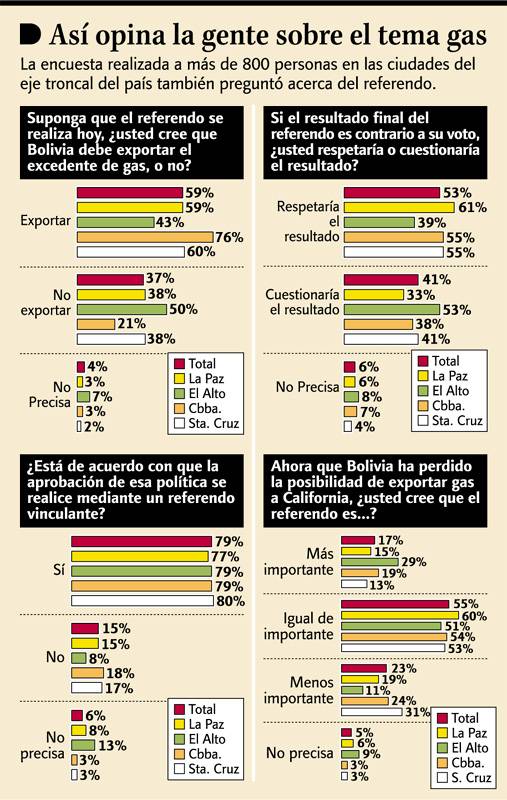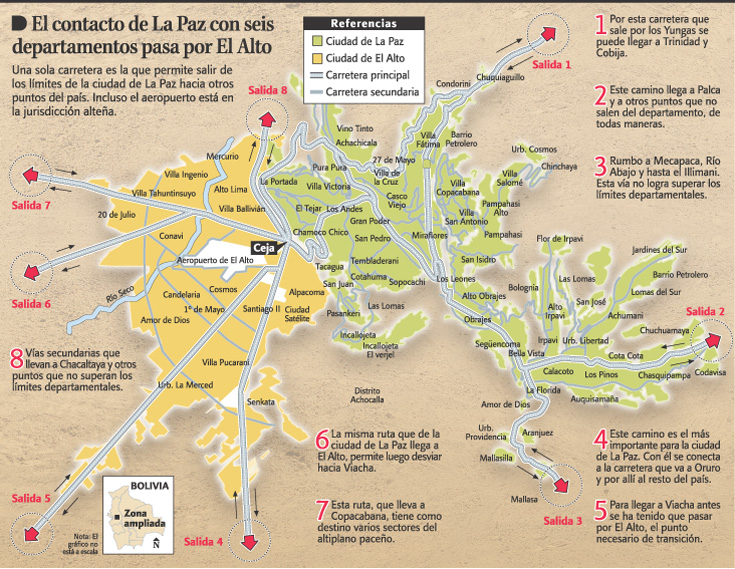There's been some attention paid to the role of El Alto (the sprawling slum twin city of La Paz) in national politics. After all, October's guerra del gas was primarily an alteño affair. It wasn't until after the city of La Paz had been besieged & cut off from the rest of the country for three weeks that the middle class finally "joined" the protesters in demanding Goni's resignation. A recent poll on the upcoming gas referendum shows just how different — and dangerous — El Alto can be.
 The poll, conducted by Apoyo Opinión y Mercado Bolivia, sampled potential voters in La Paz, El Alto, Cochabamba, and Santa Cruz (the four largest cities, w/ a combined population of more than 50% of the nation's total).
The poll, conducted by Apoyo Opinión y Mercado Bolivia, sampled potential voters in La Paz, El Alto, Cochabamba, and Santa Cruz (the four largest cities, w/ a combined population of more than 50% of the nation's total).
When asked whether they'd vote in favor of exporting gas or no, most voters (59%) said they'd vote yes. A smaller margin would also respect the results, if they contradicted their own opinion (53%). An impressive 79% were in favor of holding a referendum on this issue. And, finally, 55% felt the referendum was still important, even if Bolivia's gas export options had disappeared.
What's important to note is the discrepancy between opinions in El Alto & the other cities. Only 43% of alteños supported exporting the gas (a solid 50% opposed it, w/ only 7% undecided). More importantly, a slight majority would not respect the outcome of the popular vote if it contradicted theirs. The differences between El Alto and other cities on each of these measures was about 15%, a wide gap — especially considering that the other three cities were closely packed (w/ the exception of Cochabamba, where 76% supported gas exports).
These pieces of data are significant. What it means is that El Alto, which can strategically dominate the capital of La Paz by simple closing the 4-5 highways out of the city, is not only the most opposed to gas exports (out of sync w/ the rest of the sampled population), but won't respect the outcome of a referendum supporting gas exports.
So. Let's imagine this situation. The referendum goes forward, and voters approve (by whatever margin) the national policy of exporting natural gas. Imagine that 10% of the population of El Alto (a city of roughly 800,000) decides that they won't respect the vote's outcome — they're going to blockade the city. Does Mesa then rescind a nationwide popular mandate? Does he try to enforce it? Is he willing to send police & troops to open the highways in & out of La Paz? This is, essentially, what Goni tried to do in October. And we know how that ended.
-----
 UPDATE: Here's a map that explains La Paz's vulnerability. W/ 8 highways out of the metro area, the 3 out of La Paz itself, actually go nowhere (at least to no major urban areas). Of the 5 out of El Alto (which can all be closed at the Ceja), only Salida 4 leads to any major cities. Also, keep in mind that La Paz is built in a series of mountain ravines. So the three roads out of the city are the only way out, unless you want to climb some Andean mountains.
UPDATE: Here's a map that explains La Paz's vulnerability. W/ 8 highways out of the metro area, the 3 out of La Paz itself, actually go nowhere (at least to no major urban areas). Of the 5 out of El Alto (which can all be closed at the Ceja), only Salida 4 leads to any major cities. Also, keep in mind that La Paz is built in a series of mountain ravines. So the three roads out of the city are the only way out, unless you want to climb some Andean mountains.
Is the poll data available online?
Also, does "El Alto" surround La Paz? My geography of La Paz is weak, at best, but I thought El Alto was at an altitude higher than La Paz itself, and only on one side of the city (the NW?). So La Paz could communicate with the rest of Bolivia through the Eastern exits to the city. Is La Paz cut off then when alteños flood the city? or does El Alto ring La Paz?
(a good online map of La Paz would answer my question, if you know of one...)
Posted by mike d | February 2, 2004 01:59 PMYes, El Alto doesn't surround La Paz. But. La Paz is built along a series of mountain ravines. There are only 8 highways out of the city, five of which go through El Alto. Here's a post w/ a map of La Paz I put up on my personal blog a few months ago. The 3 highways out of La Paz proper go nowhere, at least not to any major cities (they don't leave the department of La Paz). The 5 other highways all must go through the Ceja, which can be easily barricaded (as it was during October).
Also, the data on the polls (at least the graphic) should be online tomorrow. I'm waiting for La Razón to update its archives so I can post the graphic itself.
Posted by miguel | February 2, 2004 05:45 PMMiguel:
MT doesn't allow us to mark up comments with HTML (rather, it does, but I'm not 100% sure _how_).
would you mind posting/emailing the URL of your post with the map, and I'll see what I can do to turn HTML on...
cheers
~mtd
" Version 2.1 | Mike Derham
" The Plan | Miguel Centellas
" Bellydancing And Diplomatic Indicidents | Marcelo
" El Alto & Bolivian politics | Miguel Centellas
" Sachs Bullish on Brazil | Mike Derham
" Tonight we find out | Miguel Centellas
" Mesa's role? | Miguel Centellas
" That's, Of Course, What I've Been Saying All Along | Marcelo
" The Argentine Debt: I'm Not The Only One Wondering | Marcelo
" If you have a U.S. passport and are traveling to Brazil... | Henry Schroy
" Guarani and Kaiowa Indians of Brasil struggle for their land | Henry Schroy
" "Bon Fet, Ayiti!" | Scott Barnard
" oh, where to begin? well... | Priya Lal
" more from living in latin america...
" living in india
" economy matters
" living in latin america
" china review
" bonobo land
" boulevard st michel
" bradf.com